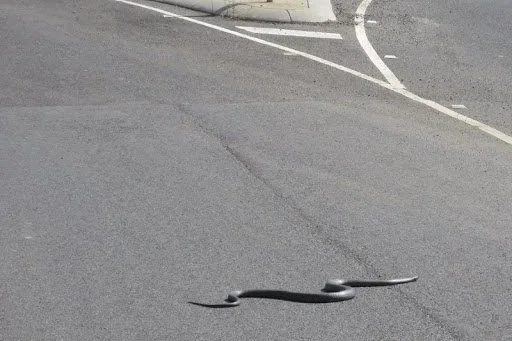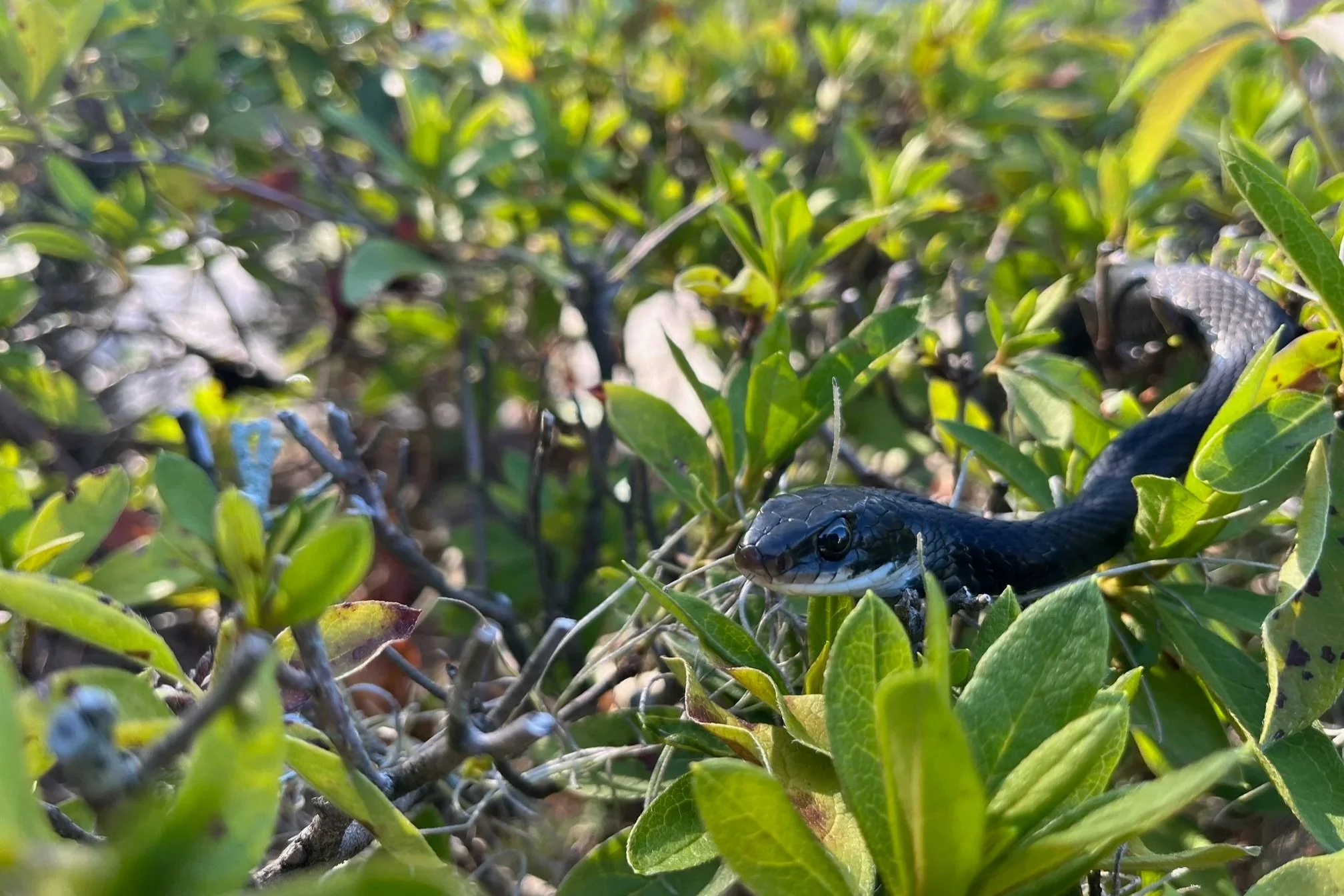SNAKES IN THE GARDEN : SUPPORTING UNIQUE WILDLIFE
PROVIDING HABITAT IN YOUR LANDSCAPE FOR BENEFICIAL SNAKES
Here at Wacca Pilatka, we create and maintain gardens that benefit both people and wildlife. When we interact with our customers, we often hear requests to have these gardens attract birds, butterflies, bees, deer and the like, but…snakes? Very seldom! In this article, we’re going to explain that snakes not only belong in our gardens, but that they desperately need them, as well as share some interesting facts on our commonly found snakes here in Northeast Florida.
Snakes Need somewhere to live
A healthy garden is diverse in species, supporting a variety of both flora and fauna. Snakes are often a misunderstood species and get a bad reputation for being the uninvited guest of the party. Well, we are here to tell you, they are more like the VIP of the party. But more like the VIP that enters through the back door and really just wants a private suite to be left alone.
Snakes are pretty introverted and anti-social critters. Most of the time, you don’t ever notice them as they like to play the ultimate game of hide and seek. This is intentional, as basking in a wide open lawn would make for an easy meal for a passing bird of prey or cat. Contrary to popular belief, they are not on a daily mission to strike and bite humans. They only really do this if you have startled or triggered them, like honking your car horn and saying hey buddy, you’re getting too close!
Black racer snake hiding within ilex shrub. Photo by Jake Tucker.
Snakes need our gardens, now more than ever, as a place where they can safely rest, find food, lay their eggs, and honestly just live their life in peace. Habitat loss and fragmentation, collection for pet trade, road mortalities and diseases such as snake lungworm, are all contributing to a rapid decline in snake populations.
Brake for snakes! Road mortalities are a large contributor to snake population decline.
Photo courtesy Joan Ko.
In return for a safe haven, snakes will thank us by providing a natural method of pest control in our gardens. Snakes primarily feed on rodents, insects, and even small mammals in your yard. Many in our area are also feasting on the invasive brown anoles, helping to control their populations. So, if you’ve never seen a rat in your garden, you may have a snake to thank for that. Snake are also nutrient cyclers and act as both predator and prey to help keep ecosystems in balance.
Snakes are a critical part of the food chain, as tertiary consumers. Image by bitWise Academy.
Common Northeast Florida Snakes
According to the UF Wildlife Johnson Lab, here in the state of Florida we have 46 native species of snakes, and 45 of them can be found in the panhandle and North Florida regions, lucky us! A majority of Florida snakes are harmless. Of the established species found in Florida, only 6 species are venomous. Snakes are venomous, not poisonous—meaning they inject toxins through a bite or fangs, whereas something poisonous harms you only if you eat or touch it.
Image courtesy of Tree Hill Nature Center
Since the majority of snakes in Florida are non-venomous, you are much more likely to encounter the beneficial variety. If you are unsure whether a snake is venomous, it is best to leave it alone and give it space. When walking around a typical garden in our area, you’re likely to come across a few common species we’ll discuss here.
Black Racers
The first beneficial snake we will discuss is our North American black racer, or Coluber constrictor, a non-venomous snake that can be found in practically every habitat type and throughout the entire state of Florida, including the Florida Keys. Feasting on a variety of food like frogs, spiders, lizards, bird eggs, and even other snakes, the black racer is not actually a true constrictor as its species name implies. Rather, it uses its tough jaws to capture and keep hold of its prey. And while it is fast as its “racer” name implies, it is not the fastest snake. In Florida, that’s likely the eastern coachwhip snake. And in the world, that title goes to the black mamba snake in Africa (if you knew that prior to reading this article, kudos to you!).
Black racer snakes like to hide within shrubs in your garden. Their white chin is a distinct characteristic to help identify it. Photo by Jake Tucker.
Black racers can usually get to about 5 feet in length and they stay generally black in color, but can have just a bit of white under their chin area. One fun fact on this frequent garden visitor, is that their juvenile snakes are often mis-identified as pygmy rattlesnakes as they have a similar blotch pattern while young. Some say this might be nature’s mimicry in action to protect the snake while young since the pygmy rattlesnake has venomous powers.
Baby black racer born with blotches similar to pygmy rattlesnakes. Photo courtesy oksnakes.org
Dusky pygmy rattlesnake, a venomous snakes is often confused with juvenile black racers.
Photo by Jake Tucker
Eastern Garter
Our second garden snake friend is the Eastern garter snake, or Thamnophis sirtalis. These snakes are smaller than racers, getting usually to only about 26 inches long. These guys are pretty unique in that while most have 3 stripes along their body, their background body color can vary, from black, to brown, greenish-brown or even gray.
Eastern garter snake amongst pine needles. Photo by Jake Tucker.
This snake is non-venomous and primarily feeds on frogs, salamanders, fresh water fish and earthworms. You’re likely to find them in suburban neighborhoods that borders undeveloped habitat, especially along the edges of flowing or standing water. Another interesting fact about these snakes is that they give live birth. Eastern garter snakes, like some others, are ovoviviparous, meaning their eggs develop and hatch inside their bodies, thus enabling a “live birth”.
Red Rat or Red Cornsnakes
Last, but not least, we have red rat snakes or red corn snakes, Pantherophis guttatus. Known to be one the best climbing species of snakes in Florida, red rat snakes are non-venomous and can get about 4 feet long.
Red rat snakes have an intimidating coloration of reddish-orange, with brown blotches that often results in mis-identifying as a non-venomous king snake, or the venomous coral snake.
Photo by Jake Tucker.
Red rat snake climbing tree trunk. Photo courtesy David Holmes.
According to the Florida Museum of Natural History, the common name “cornsnake” for this species came from its role in natural pest control many years ago. When farmers harvested corn and built “cribs” for its storage, many rodents would come around and start eating the corn. Red cornsnakes in these cribs would in turn, eat the rodents and helped save the corn.
Image courtesy of Emerald Coast Wildlife Refuge
Unfortunately, as you can see above, some of these guys have gotten a bad rap due to a case of mistaken identity. Educating yourself is your best tool to keep yourself and wildlife safe. The Florida Museum has a handy identification tool on their site to help identify different species of snakes you may find in Florida. If you do think you’ve seen another species of snake that doesn’t look like ike some of these common species typically found in your gardens, we encourage you to report your sighting to Fish and Wildlife Commission (FWC) via the Florida Rare Snake Registry.
What can I do to attract snakes to my garden?
So now you’re coming around to the idea that snakes are cool and it would be awesome to see one in your garden. What can you do? Thankfully, you don’t need to do much! Many of the features that attract snakes to gardens are already there, we just need to leave them be. Snakes like to hang out on leaf litter, under rotting logs or abandoned holes, so if you have some of these in your garden, instead of picking up some of this debris, leave it in place, or move it elsewhere where it’s not unsightly to you, but favorable to a passing snake. Snakes also enjoy the safety in dense or overgrown grass. So if you don’t mind leaving a certain area in your backyard unmowed, you know you’ll be helping your snake neighbor.
Unmowed spaces and even wooden debris that snakes can hide under are great ways to provide habitats for snakes in your garden. Photo by Jake Tucker.
If you’re curious about what to do if you encounter a snake in your garden, the Florida Museum also has some helpful info on how to handle that scenario so that you may safely coexist. Probably one of the best things you can do to help our snake friends is to avoid triggering or approaching them too quickly. This stresses snakes and attempting to or actually picking them if you’re not a trained handler can inadvertently hurt the snake and even transfer diseases to and from the snake.
To learn more about what you can do to support wildlife in your landscape, check out our past blog Planning and Pruning for Wildlife in your Garden. We haven’t covered all of the snakes in Florida, so if you are curious to do more research, by all means explore! UF Wildlife-Johnson Lab has great resources, as well as WildlifeFlorida.org.
Conclusion
For those of you that follow or know of the traditional Chinese calendar, 2025 happens to be the year of the snake, symbolizing wisdom and transformation. So lets transform those old fears of snakes in our gardens and instead be curious and welcome them! In fact, we challenge you to go out there and find some of our slithering friends, snap a pic and tag us on IG @waccapilatka!
WANT HELP TRANSFORMING YOUR YARD INTO A WILDLIFE HAVEN?
Reach out to us at Wacca Pilatka to transform your yard into a thriving, low-maintenance landscape where every plant has a purpose. By using native and Florida friendly plants, we create spaces that naturally invite butterflies, birds, and even helpful snakes—nature’s own pest control—to keep the ecosystem in balance. The result is a beautiful, resilient outdoor space that feels alive, reduces the need for chemicals, and connects you more deeply to the rhythms of the natural world.















